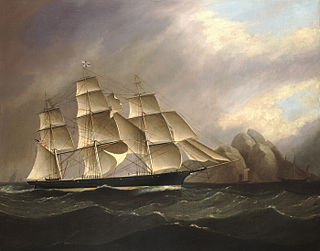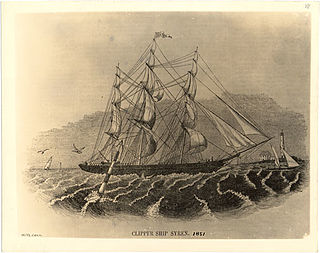
A clipper was a type of mid-19th-century merchant sailing vessel, designed for speed. Clippers were generally narrow for their length, small by later 19th-century standards, could carry limited bulk freight, and had a large total sail area. "Clipper" does not refer to a specific sailplan; clippers may be schooners, brigs, brigantines, etc., as well as full-rigged ships. Clippers were mostly constructed in British and American shipyards, although France, Brazil, the Netherlands, and other nations also produced some. Clippers sailed all over the world, primarily on the trade routes between the United Kingdom and China, in transatlantic trade, and on the New York-to-San Francisco route around Cape Horn during the California Gold Rush. Dutch clippers were built beginning in the 1850s for the tea trade and passenger service to Java.

Star of India is an iron-hulled sailing ship, built in 1863 in Ramsey, Isle of Man as the full-rigged ship Euterpe. After a career sailing from Great Britain to India and New Zealand, she was renamed, re-rigged as a barque, and became a salmon hauler on the Alaska to California route. Retired in 1926, she was restored as a seaworthy museum ship in 1962–3 and home-ported at the Maritime Museum of San Diego in San Diego, California. She is the oldest ship still sailing regularly and also the oldest iron-hulled merchant ship still afloat. The ship is both a California Historical Landmark and United States National Historic Landmark.

Cutty Sark is a British clipper ship. Built on the River Leven, Dumbarton, Scotland in 1869 for the Jock Willis Shipping Line, she was one of the last tea clippers to be built and one of the fastest, at the end of a long period of design development for this type of vessel, which ended as steamships took over their routes. She was named after the short shirt of the fictional witch in Robert Burns' poem Tam o' Shanter, first published in 1791.

RRS Discovery is a barque-rigged auxiliary steamship built in Dundee, Scotland for Antarctic research. Launched in 1901, she was the last traditional wooden three-masted ship to be built in the United Kingdom. Her first mission was the British National Antarctic Expedition, carrying Robert Falcon Scott and Ernest Shackleton on their first, and highly successful, journey to the Antarctic, known as the Discovery Expedition.

Donald McKay was a British North America-born American designer and builder of sailing ships, famed for his record-setting extreme clippers.

Iron-hulled sailing ships represented the final evolution of sailing ships at the end of the age of sail. They were built to carry bulk cargo for long distances in the nineteenth and early twentieth centuries. They were the largest of merchant sailing ships, with three to five masts and square sails, as well as other sail plans. They carried lumber, guano, grain or ore between continents. Later examples had steel hulls. They are sometimes referred to as "windjammers" or "tall ships". Several survive, variously operating as school ships, museum ships, restaurant ships, and cruise ships.

Blackadder was a clipper, a sister ship to Hallowe'en, built in 1870 by Maudslay, Sons & Field at Greenwich for Jock Willis & Sons.

City of Adelaide is a clipper ship, built in Sunderland, England, and launched on 7 May 1864. It was built by Pile, Hay and Co. to transport passengers and goods between Britain and Australia. Between 1864 and 1887 she made 23 annual return voyages from London and Plymouth to Adelaide, South Australia and played an important part in the immigration of Australia. On the return voyages she carried passengers, wool, and copper from Adelaide and Port Augusta to London. From 1869 to 1885 she was part of Harrold Brothers' "Adelaide Line" of clippers.

The clipper route was derived from the Brouwer Route and was sailed by clipper ships between Europe and the Far East, Australia and New Zealand. The route, devised by the Dutch navigator Hendrik Brouwer in 1611, reduced the time of a voyage between The Netherlands and Java, in the Dutch East Indies, from almost 12 months to about six months, compared to the previous Arab and Portuguese monsoon route.

SS Asiatic was a steamship operated by the White Star Line from 1871 to 1873, a sister ship to Tropic. Sold off after only two years, she was renamed SS Ambriz, and eventually was wrecked in 1903.
SS Fazilka was a British India Steam Navigation Company (BI) steamship. She was built in England in 1890, operated mostly in the Indian Ocean, and was wrecked in the Nicobar Islands in 1919. She was a troop ship in the Second Boer War and the First World War. From 1901 to 1907 she took Indian indentured labourers to Fiji.

HMS Calcutta was the East Indiaman Warley, converted to a Royal Navy 56-gun fourth rate. This ship of the line served for a time as an armed transport. She also transported convicts to Australia in a voyage that became a circumnavigation of the world. The French 74-gun Magnanime captured Calcutta in 1805. In 1809, after she ran aground during the Battle of the Basque Roads and her crew had abandoned her, a British boarding party burned her.

Ocean Telegraph was a clipper ship that was built in Massachusetts in 1854 and was last known of in Gibraltar in 1923. She was in US ownership until 1863, when UK interests bought her and renamed her Light Brigade.

Comet was an 1851 California clipper built by William H. Webb which sailed in the Australia trade and the tea trade. This extreme clipper was very fast. She had record passages on two different routes: New York City to San Francisco, and Liverpool to Hong Kong, and beat the famous clipper Flying Dutchman in an 1853 race around the Horn to San Francisco.

Syren was the longest lived of all the clipper ships, with a sailing life of 68 years 7 months. She sailed in the San Francisco trade, in the Far East, and transported whaling products from Hawaii and the Arctic to New Bedford.

SS Pericles was a UK steam ocean liner and refrigerated cargo ship. She was launched in 1907 in Ireland for the Aberdeen Line service between Great Britain and Australia via South Africa. When new, she was the largest ship on the route.

Starlight was a medium clipper built in 1854 in South Boston, Massachusetts that made nine passages from New York City or Boston to San Francisco. The ship was known in its day for "making passages faster than average". Starlight is better remembered today as the subject of two paintings by artist Fitz Hugh Lane. Starlight was described as having "spacious staterooms" and a figurehead resembling "the representation of an antediluvian bird of Paradise spliced into a mermaid".

Orient was a wooden-hulled, three-masted sailing ship that was built in England in 1853 and scrapped in Gibraltar in 1925. She served in the Crimean War, and then spent two decades with James Thompson & Co's "Orient Line" of ships sailing between Great Britain and South Australia.

Larkins made ten voyages for the British East India Company (EIC), all as an "extra ship", i.e. under contract. On two of these voyages she first transported convicts to Australia. She also made one convict voyage independently of the EIC. She traded extensively between England and India or China, and in this twice suffered serious but not fatal maritime mishaps. In 1853 she became a coal hulk at Albany, Western Australia, and remained there until she was broken up in 1876.
Portsea was launched at Calcutta in 1807. She was a country ship; that is, she primarily traded east of the Cape of Good Hope. She participated as a transport in the British invasion of Mauritius. She then carried French prisoners of war to France. She also made one voyage to St Helena from Bengal under charter to the British East India Company (EIC). In 1814 a storm dismasted her and she was lengthened, but it is not clear whether before or after the dismasting. She made two voyages as a South Seas whaler between 1828 and 1835. In 1838 she made one voyage transporting convicts to New South Wales. She carried coal to Valparaiso in 1840 and there her owners turned her into a coal hulk. Her final fate is not known.



















